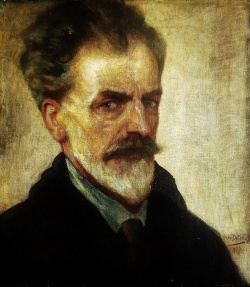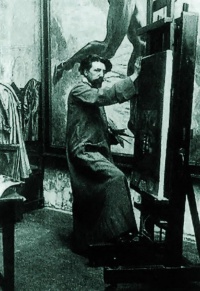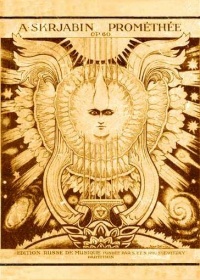Jean Delville
UNDER CONSTRUCTION
UNDER CONSTRUCTION
Jean Delville (1867–1953) was a Belgian symbolist painter, author, and teacher. He was the first General Secretary of the Theosophical Society in Belgium, from 1911-1913.
Early years
Jean Delville was born in Louvain, Belgium on July 10, 1867. As a boy he was not interested in school, so at age 15 his parents allowed him to enroll in the Schools of Arts at Brussels. After two years of study, he was awarded prizes for composition, painting and drawing from life. [1][2]
Artistic career
Delville created works of art with great technical skill and originality. He tried to find a style apart from the naturalistic aestheticism and the materialistic realism of the day; his work is idealistic.
First exhibition
Deville's first publicly exhibited painting was a large canvas called Le Cycle Passionel of a nude woman. He was just eighteen, and the year was 1885.
Young Delville depicted the whirlwind of sensual desire and lewdness which Dante had described in the Inferno. The picture caught the attention of the art-critics by its disclosure of a new genius of the brush who possessed not only phenomenal skill but great power of conception. It also struck the note of exalted seriousness which has characterised all his work... [his pictures], while classical in their structural and technical perfection, made no concession to softness or sentimentality and always made the affirmation of power and chastity.[3]
Artistic style
Delville's work has been compared to ..........
Dr. James Cousins, who greatly admired Nicholas Roerich as well as Deville, wrote: "Jean Delville of Belgium, who, if Roerich be Castor in the firmament of art, is assuredly his true brother Pollux."[4]
Paintings, exhibitions, and prizes
- Le Cycle Passionel was his first exhibited work, in 1885.
- Christ Glorified by the Children won the Grand Prix de Rome in 1895.
- Treasures of Patin in 1895
- The School of Plato, painted in 1899, won the highest honor at the Universal Exhibition at Milan.
- Love of Souls won the silver medal of the Paris Universal Exhibition of 1900.
- The Man-God.
- Prometheus cover art for Scriabin's score, painted in 1908.
- Murals in Palais de Justice, Brussels in 1914
- The Shudder of the Sphinx
- The Unknown Splendours
- The Haunted Horizon
Organizations of artists
In 1896, Delville founded the Salon d'art Idéalist, with Léon Frédéric, Auguste Levêque, Albert Ciamberlani, Constant Montald, Emile Motte, Victor Rousseau, Armand Point and Alexandre Séon among the members. These artists wanted art to go beyond realism and materialism into the concepts of the ideal. Aesthetic principles from freemasonry, rosicrucianism, and theosophy predominated in this group.
Theosophical Society involvement
Delville became a member of the Theosophical Society in the late 1890s.
Delville was a founder of the Theosophical Society in Belgium and served as its first General Secretary in the years 1911-1913, with Gaston Polak succeeding him.[5] He was a National Representative of the Order of the Star in the East.[6]
Friendship with Scriabin
In 1908, Russian composer and pianist Alexander Scriabin relocated to Brussels, and there met Delville.
When Scriabin composed his fifth symphony, Prometheus or "The Poem of Fire" in 1909-1910, Delville created the cover art for the score.
Delville, and perhaps Scriabin, had joined a secret cult within Theosophy called "Sons of the Flames of Wisdom." They worshiped Prometheus, because those fires, colors, lights were metasymbols of man's highest thoughts. Fire was Prometheus's stolen gift to man...[7]
Scriabin was delighted with the androgynous face and the symbolism.
Friendship with James Cousins
Dr. James Cousins, an Irish Irish writer, critic, and teacher, wrote of his first meeting with Jean Delville:
I here thanks God (or whoever it was) who led me in the summer of 1925 to the presence of Jean Delville in Brussels and to the discovery of one of the world's master-artists and most exalted geniuses - an artist who, on the peak of achievement in his craft and in its recognition among those who know, counts it not inexpedient to be publicly identified with Theosophy , and wears, as naturally as he wears his coat, the badge of the National Representative of the Order of the Star in the East. Or the joy and inspiration of that meeting, with its immediate merging of mind with mind in the brotherhood of the spirit; for its gift to me of a vast and exalted realm of art, and a glorious ratification of some of my dreams of what the Theosophical spirit in art may accomplish for the beckoning of humanity towards the heights, I would here make acknowledgment...[8]
Old notes
According to Wikipedia:
In 1895 Delville published his Dialogue entre nous, a text in which he outlined his views on occultism and esoteric philosophy. Brendan Cole discusses this text in detail his book on Delville, pointing out that, though the Dialogue reflects the ideas of a number of occultists, it also reveals a new interest in Theosophy. In the late 1890s, Delville joined the Theosophical Society. He was probably introduced to Theosophy directly through his friendship with Edouard Schuré, the author of the widely-influential book Les Grandes Initiés. Schuré wrote the preface to Delville's work on Idealist Art, La Mission de l'Art (1900). Delville also came into close alliance with Annie Besant who inherited the leadership of the Theosophical movement. Besant gave a series of lectures in Brussels in 1899 titled La Sagesse Antique. Delville reviewed her talks in an article published in Le Thyrse that year.[9] It is probably from this point onwards that Delville became actively involved in the Theosophical Movements as such. Delville founded La Lumière, a journal devoted to Theosophical ideas in 1899, and published articles from leading Theosophists of the day, including Besant. Delville became the first General Secretary of the Belgian branch of the Theosophical Society in 1911.[10]
Delville's art flourished after 1900 and he produced some of his greatest works during this period up to the First World War. He worked with undiminished strength and imagination and his paintings revealed a visionary sense of the transcendental inspired by his involvement in the Theosophical movement, seen typically in works such as his monumental L'Homme-Dieu (1903, Brughes: Groeninge Museum) and Prométhée (1907, Free University Brussels).
Other resources
The Union Index of Theosophical Periodicals lists 22 articles by or about Delville.
Articles
- Harris, Philip S. "Delville, Jean." Theosophical Encyclopedia (Quezon City, Philippines: Theosophical Publishing House, 2006), 191-192. Available at Theosopedia.
- Jean Delville: Painting, Spirituality, and the Esoteric by Lynda Harris
- Jean Delville at Wikipedia
Notes
- ↑ "Who's Who in the Theosophical Society: Delville, Jean," The Theosophical Year Book, 1938 (Adyar, Madras, India: Theosophical Publishing House, 177.
- ↑ Ted G. Davy, "Arnold, Edwin," Theosophical Encyclopedia (Quezon City, Philippines: Theosophical Publishing House, 2006), 49. Available at Theosopedia.
- ↑ James H. Cousins, "The Life and Work of Jean Delville" The Theosophist 47.3 (December, 1925), 398.
- ↑ James H. Cousins, "The Life and Work of Jean Delville, Theosophist Painter-Poet." The Theosophist47.3 (December 1925), 396.
- ↑ "General Secretaries Past and Present," The Theosophical Year Book, 1938 (Adyar, Madras, India: Theosophical Publishing House, 152.
- ↑ James H. Cousins, "The Life and Work of Jean Delville, Theosophist Painter-Poet." The Theosophist47.3 (December 1925), 397.
- ↑ Faubion Bowers, Scriabin: A Biography of the Russian Composer 1871-1915, Volume II (Tokyo:Kodansha International Ltd, 1969), 206-207.
- ↑ James H. Cousins, "The Life and Work of Jean Delville, Theosophist Painter-Poet." The Theosophist47.3 (December 1925), 396-397.
- ↑ Delville, 'A propos de la Sagesse Antique. Conference de Mme Annie Besant', Le Thyrse, nr 9, 1st September 1899, pp. 65-6.
- ↑ See Flaurette Gautier, Jean Delville et l'occulture fin de siècle. Unpublished Master's thesis, Tours: University François-Rabelais, 2012.
]



